HI5017 Managerial Accounting Assignment: ABC Model Analysis Report
VerifiedAdded on 2023/06/08
|16
|4168
|223
Report
AI Summary
This report provides a comprehensive analysis of the Activity Based Costing (ABC) model within the context of managerial accounting. It begins with an executive summary and introduction, followed by an explanation of the ABC model itself, detailing its processes and benefits. The report then focuses on two research studies: "Implementation of the Activity Based Costing Model for a Farm: An Australian Case" and "The Impact of Activity based Costing on Organizational Performance." It explores the purpose and research questions of each study, highlighting similarities and differences in their findings. The report also extracts four key lessons useful for management accountants in Australian companies. Finally, the report concludes by summarizing the key takeaways and implications of the ABC model for cost management and organizational performance. The report emphasizes the importance of accurate cost allocation, particularly in scenarios involving outsourcing or departmental downsizing. The report also discusses the significance of ABC in identifying and eliminating non-value-added activities, leading to enhanced operational efficiency and strategic decision-making.
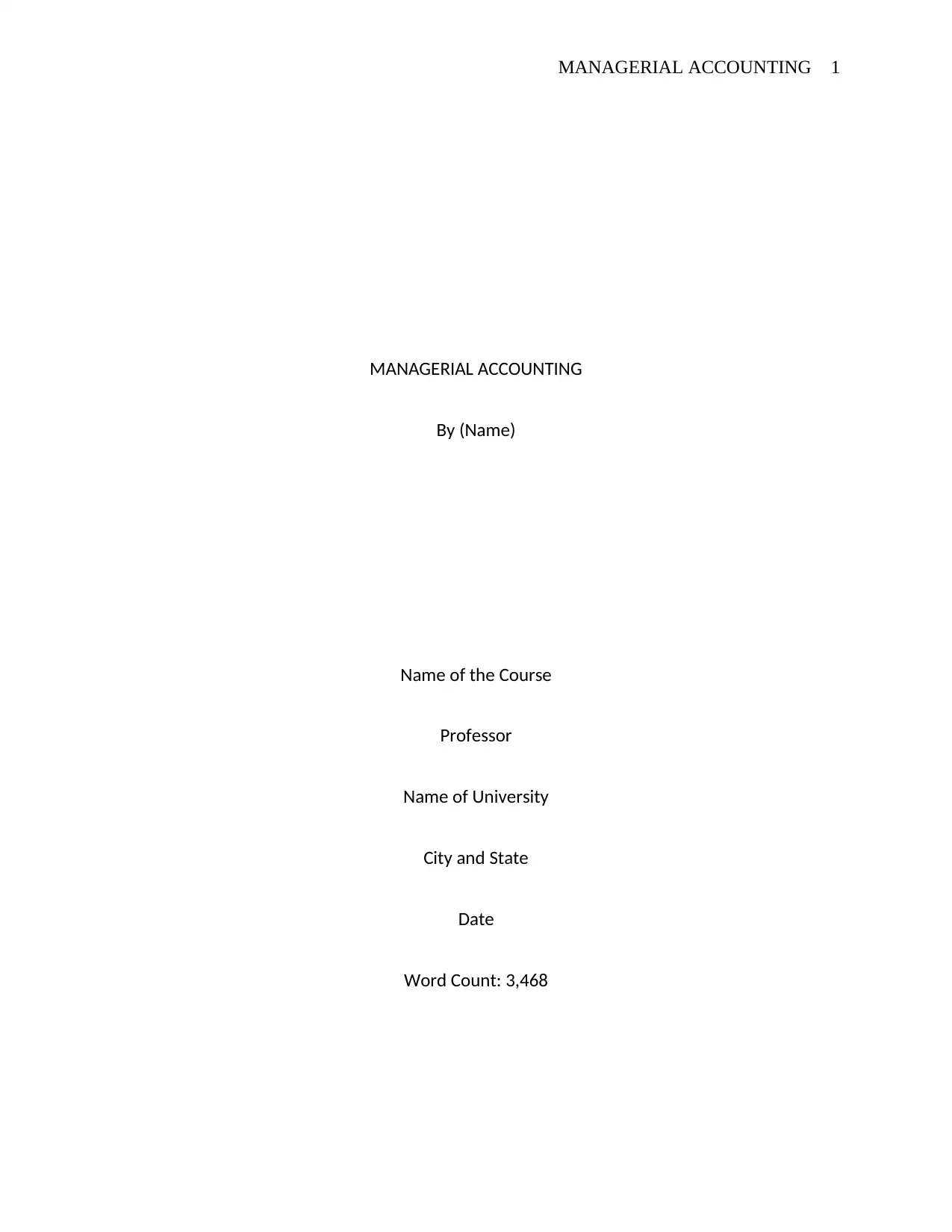
MANAGERIAL ACCOUNTING 1
MANAGERIAL ACCOUNTING
By (Name)
Name of the Course
Professor
Name of University
City and State
Date
Word Count: 3,468
MANAGERIAL ACCOUNTING
By (Name)
Name of the Course
Professor
Name of University
City and State
Date
Word Count: 3,468
Paraphrase This Document
Need a fresh take? Get an instant paraphrase of this document with our AI Paraphraser
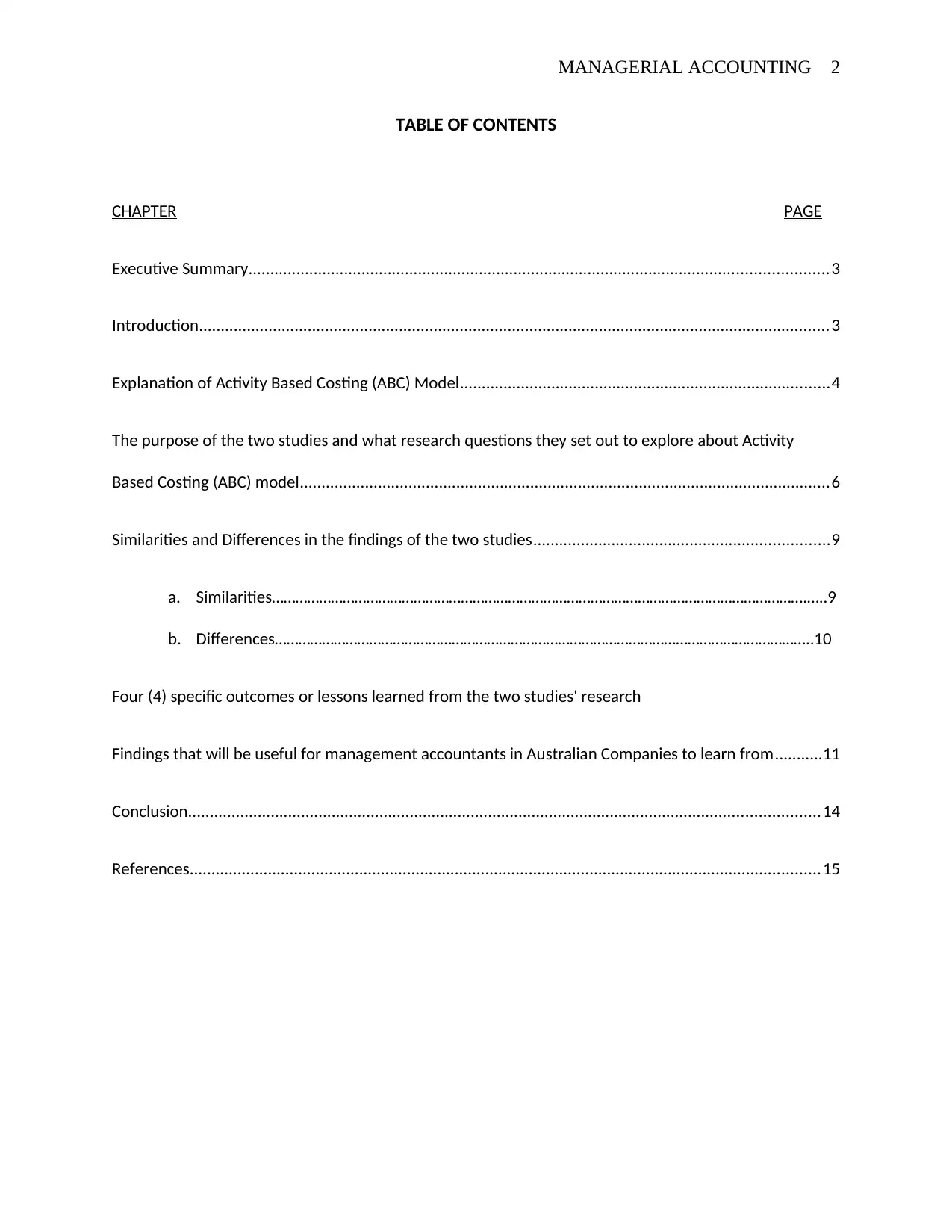
MANAGERIAL ACCOUNTING 2
TABLE OF CONTENTS
CHAPTER PAGE
Executive Summary.....................................................................................................................................3
Introduction.................................................................................................................................................3
Explanation of Activity Based Costing (ABC) Model.....................................................................................4
The purpose of the two studies and what research questions they set out to explore about Activity
Based Costing (ABC) model..........................................................................................................................6
Similarities and Differences in the findings of the two studies....................................................................9
a. Similarities……………………………………………………………………………………………………………………….…..9
b. Differences………………………………………………………………………………………………………………………..10
Four (4) specific outcomes or lessons learned from the two studies' research
Findings that will be useful for management accountants in Australian Companies to learn from...........11
Conclusion.................................................................................................................................................14
References.................................................................................................................................................15
TABLE OF CONTENTS
CHAPTER PAGE
Executive Summary.....................................................................................................................................3
Introduction.................................................................................................................................................3
Explanation of Activity Based Costing (ABC) Model.....................................................................................4
The purpose of the two studies and what research questions they set out to explore about Activity
Based Costing (ABC) model..........................................................................................................................6
Similarities and Differences in the findings of the two studies....................................................................9
a. Similarities……………………………………………………………………………………………………………………….…..9
b. Differences………………………………………………………………………………………………………………………..10
Four (4) specific outcomes or lessons learned from the two studies' research
Findings that will be useful for management accountants in Australian Companies to learn from...........11
Conclusion.................................................................................................................................................14
References.................................................................................................................................................15
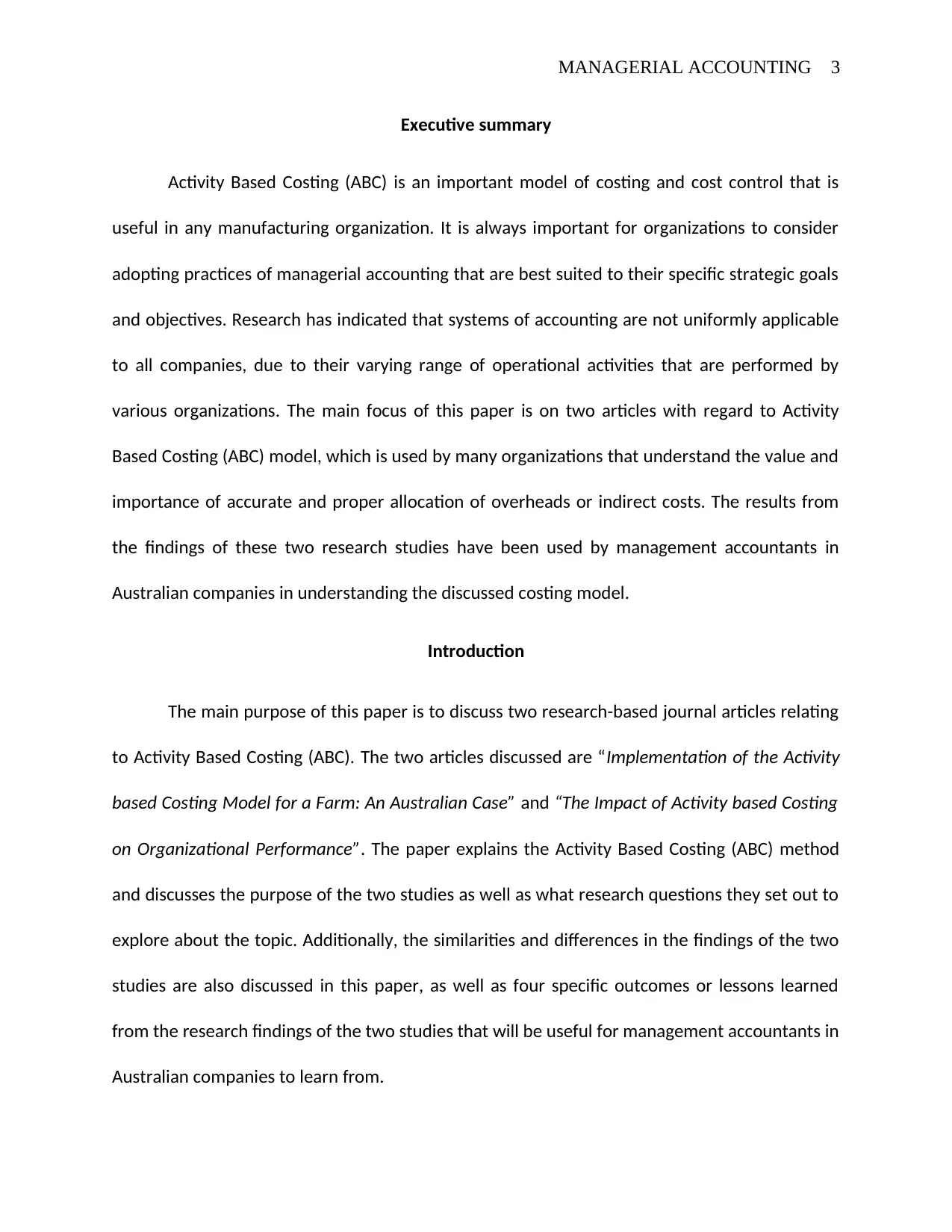
MANAGERIAL ACCOUNTING 3
Executive summary
Activity Based Costing (ABC) is an important model of costing and cost control that is
useful in any manufacturing organization. It is always important for organizations to consider
adopting practices of managerial accounting that are best suited to their specific strategic goals
and objectives. Research has indicated that systems of accounting are not uniformly applicable
to all companies, due to their varying range of operational activities that are performed by
various organizations. The main focus of this paper is on two articles with regard to Activity
Based Costing (ABC) model, which is used by many organizations that understand the value and
importance of accurate and proper allocation of overheads or indirect costs. The results from
the findings of these two research studies have been used by management accountants in
Australian companies in understanding the discussed costing model.
Introduction
The main purpose of this paper is to discuss two research-based journal articles relating
to Activity Based Costing (ABC). The two articles discussed are “Implementation of the Activity
based Costing Model for a Farm: An Australian Case” and “The Impact of Activity based Costing
on Organizational Performance”. The paper explains the Activity Based Costing (ABC) method
and discusses the purpose of the two studies as well as what research questions they set out to
explore about the topic. Additionally, the similarities and differences in the findings of the two
studies are also discussed in this paper, as well as four specific outcomes or lessons learned
from the research findings of the two studies that will be useful for management accountants in
Australian companies to learn from.
Executive summary
Activity Based Costing (ABC) is an important model of costing and cost control that is
useful in any manufacturing organization. It is always important for organizations to consider
adopting practices of managerial accounting that are best suited to their specific strategic goals
and objectives. Research has indicated that systems of accounting are not uniformly applicable
to all companies, due to their varying range of operational activities that are performed by
various organizations. The main focus of this paper is on two articles with regard to Activity
Based Costing (ABC) model, which is used by many organizations that understand the value and
importance of accurate and proper allocation of overheads or indirect costs. The results from
the findings of these two research studies have been used by management accountants in
Australian companies in understanding the discussed costing model.
Introduction
The main purpose of this paper is to discuss two research-based journal articles relating
to Activity Based Costing (ABC). The two articles discussed are “Implementation of the Activity
based Costing Model for a Farm: An Australian Case” and “The Impact of Activity based Costing
on Organizational Performance”. The paper explains the Activity Based Costing (ABC) method
and discusses the purpose of the two studies as well as what research questions they set out to
explore about the topic. Additionally, the similarities and differences in the findings of the two
studies are also discussed in this paper, as well as four specific outcomes or lessons learned
from the research findings of the two studies that will be useful for management accountants in
Australian companies to learn from.
⊘ This is a preview!⊘
Do you want full access?
Subscribe today to unlock all pages.

Trusted by 1+ million students worldwide
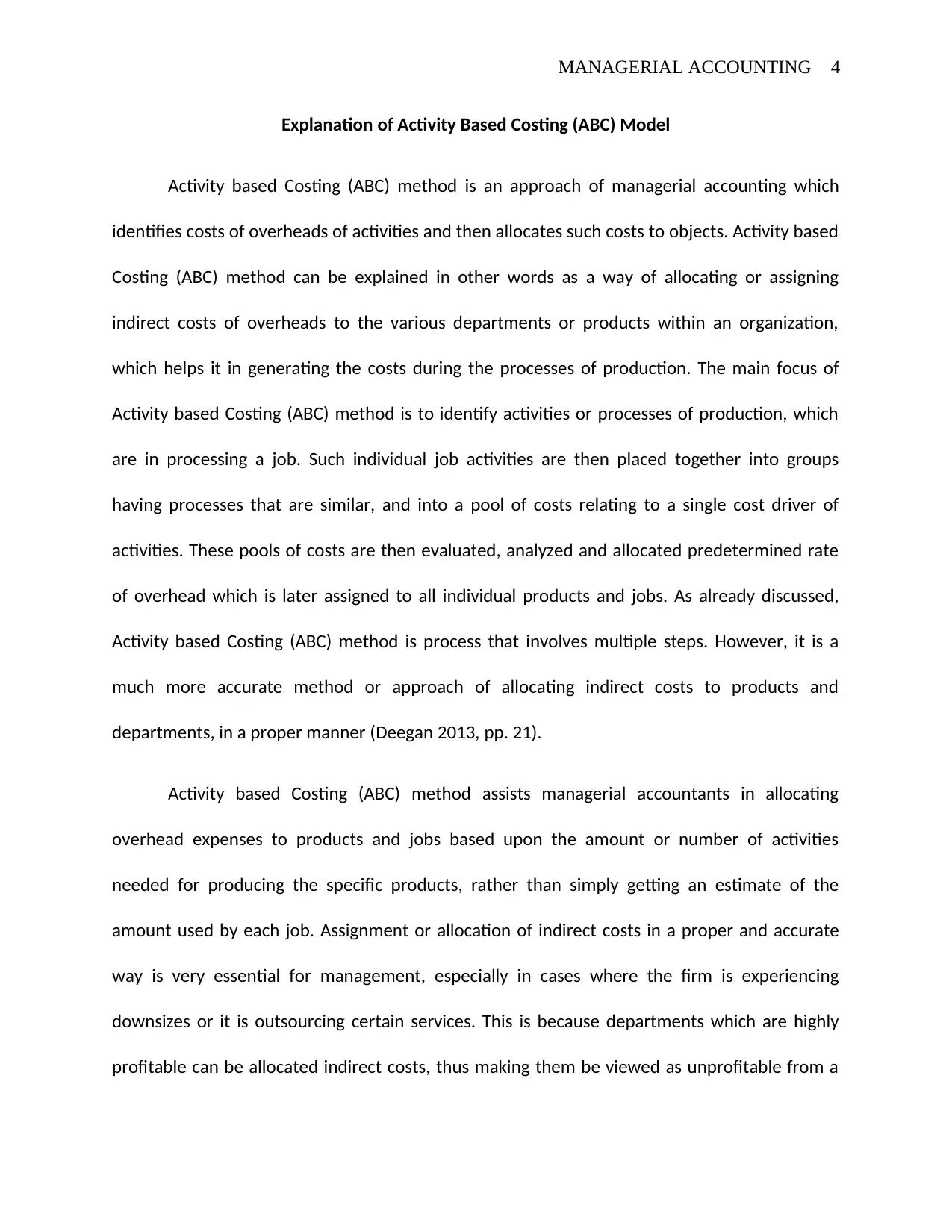
MANAGERIAL ACCOUNTING 4
Explanation of Activity Based Costing (ABC) Model
Activity based Costing (ABC) method is an approach of managerial accounting which
identifies costs of overheads of activities and then allocates such costs to objects. Activity based
Costing (ABC) method can be explained in other words as a way of allocating or assigning
indirect costs of overheads to the various departments or products within an organization,
which helps it in generating the costs during the processes of production. The main focus of
Activity based Costing (ABC) method is to identify activities or processes of production, which
are in processing a job. Such individual job activities are then placed together into groups
having processes that are similar, and into a pool of costs relating to a single cost driver of
activities. These pools of costs are then evaluated, analyzed and allocated predetermined rate
of overhead which is later assigned to all individual products and jobs. As already discussed,
Activity based Costing (ABC) method is process that involves multiple steps. However, it is a
much more accurate method or approach of allocating indirect costs to products and
departments, in a proper manner (Deegan 2013, pp. 21).
Activity based Costing (ABC) method assists managerial accountants in allocating
overhead expenses to products and jobs based upon the amount or number of activities
needed for producing the specific products, rather than simply getting an estimate of the
amount used by each job. Assignment or allocation of indirect costs in a proper and accurate
way is very essential for management, especially in cases where the firm is experiencing
downsizes or it is outsourcing certain services. This is because departments which are highly
profitable can be allocated indirect costs, thus making them be viewed as unprofitable from a
Explanation of Activity Based Costing (ABC) Model
Activity based Costing (ABC) method is an approach of managerial accounting which
identifies costs of overheads of activities and then allocates such costs to objects. Activity based
Costing (ABC) method can be explained in other words as a way of allocating or assigning
indirect costs of overheads to the various departments or products within an organization,
which helps it in generating the costs during the processes of production. The main focus of
Activity based Costing (ABC) method is to identify activities or processes of production, which
are in processing a job. Such individual job activities are then placed together into groups
having processes that are similar, and into a pool of costs relating to a single cost driver of
activities. These pools of costs are then evaluated, analyzed and allocated predetermined rate
of overhead which is later assigned to all individual products and jobs. As already discussed,
Activity based Costing (ABC) method is process that involves multiple steps. However, it is a
much more accurate method or approach of allocating indirect costs to products and
departments, in a proper manner (Deegan 2013, pp. 21).
Activity based Costing (ABC) method assists managerial accountants in allocating
overhead expenses to products and jobs based upon the amount or number of activities
needed for producing the specific products, rather than simply getting an estimate of the
amount used by each job. Assignment or allocation of indirect costs in a proper and accurate
way is very essential for management, especially in cases where the firm is experiencing
downsizes or it is outsourcing certain services. This is because departments which are highly
profitable can be allocated indirect costs, thus making them be viewed as unprofitable from a
Paraphrase This Document
Need a fresh take? Get an instant paraphrase of this document with our AI Paraphraser
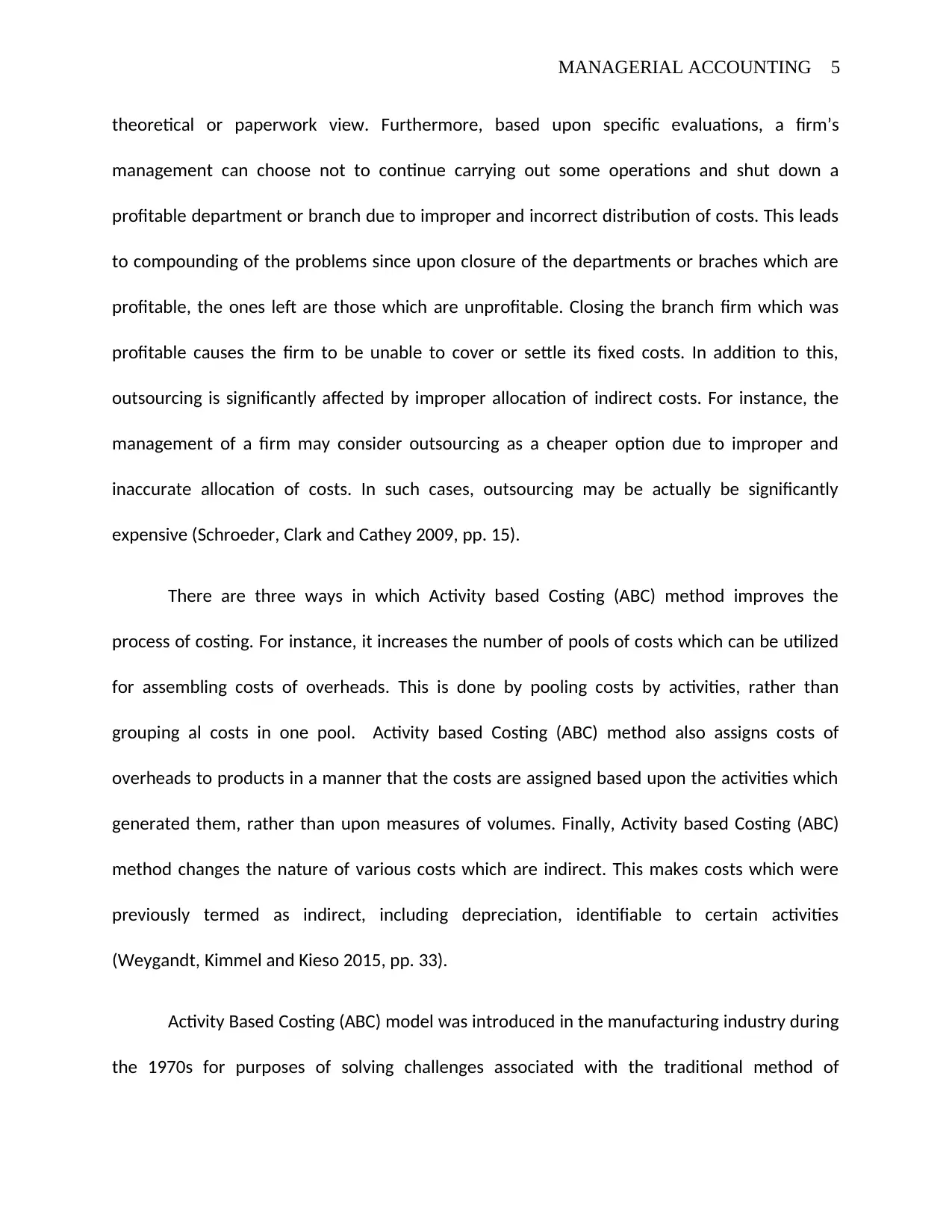
MANAGERIAL ACCOUNTING 5
theoretical or paperwork view. Furthermore, based upon specific evaluations, a firm’s
management can choose not to continue carrying out some operations and shut down a
profitable department or branch due to improper and incorrect distribution of costs. This leads
to compounding of the problems since upon closure of the departments or braches which are
profitable, the ones left are those which are unprofitable. Closing the branch firm which was
profitable causes the firm to be unable to cover or settle its fixed costs. In addition to this,
outsourcing is significantly affected by improper allocation of indirect costs. For instance, the
management of a firm may consider outsourcing as a cheaper option due to improper and
inaccurate allocation of costs. In such cases, outsourcing may be actually be significantly
expensive (Schroeder, Clark and Cathey 2009, pp. 15).
There are three ways in which Activity based Costing (ABC) method improves the
process of costing. For instance, it increases the number of pools of costs which can be utilized
for assembling costs of overheads. This is done by pooling costs by activities, rather than
grouping al costs in one pool. Activity based Costing (ABC) method also assigns costs of
overheads to products in a manner that the costs are assigned based upon the activities which
generated them, rather than upon measures of volumes. Finally, Activity based Costing (ABC)
method changes the nature of various costs which are indirect. This makes costs which were
previously termed as indirect, including depreciation, identifiable to certain activities
(Weygandt, Kimmel and Kieso 2015, pp. 33).
Activity Based Costing (ABC) model was introduced in the manufacturing industry during
the 1970s for purposes of solving challenges associated with the traditional method of
theoretical or paperwork view. Furthermore, based upon specific evaluations, a firm’s
management can choose not to continue carrying out some operations and shut down a
profitable department or branch due to improper and incorrect distribution of costs. This leads
to compounding of the problems since upon closure of the departments or braches which are
profitable, the ones left are those which are unprofitable. Closing the branch firm which was
profitable causes the firm to be unable to cover or settle its fixed costs. In addition to this,
outsourcing is significantly affected by improper allocation of indirect costs. For instance, the
management of a firm may consider outsourcing as a cheaper option due to improper and
inaccurate allocation of costs. In such cases, outsourcing may be actually be significantly
expensive (Schroeder, Clark and Cathey 2009, pp. 15).
There are three ways in which Activity based Costing (ABC) method improves the
process of costing. For instance, it increases the number of pools of costs which can be utilized
for assembling costs of overheads. This is done by pooling costs by activities, rather than
grouping al costs in one pool. Activity based Costing (ABC) method also assigns costs of
overheads to products in a manner that the costs are assigned based upon the activities which
generated them, rather than upon measures of volumes. Finally, Activity based Costing (ABC)
method changes the nature of various costs which are indirect. This makes costs which were
previously termed as indirect, including depreciation, identifiable to certain activities
(Weygandt, Kimmel and Kieso 2015, pp. 33).
Activity Based Costing (ABC) model was introduced in the manufacturing industry during
the 1970s for purposes of solving challenges associated with the traditional method of
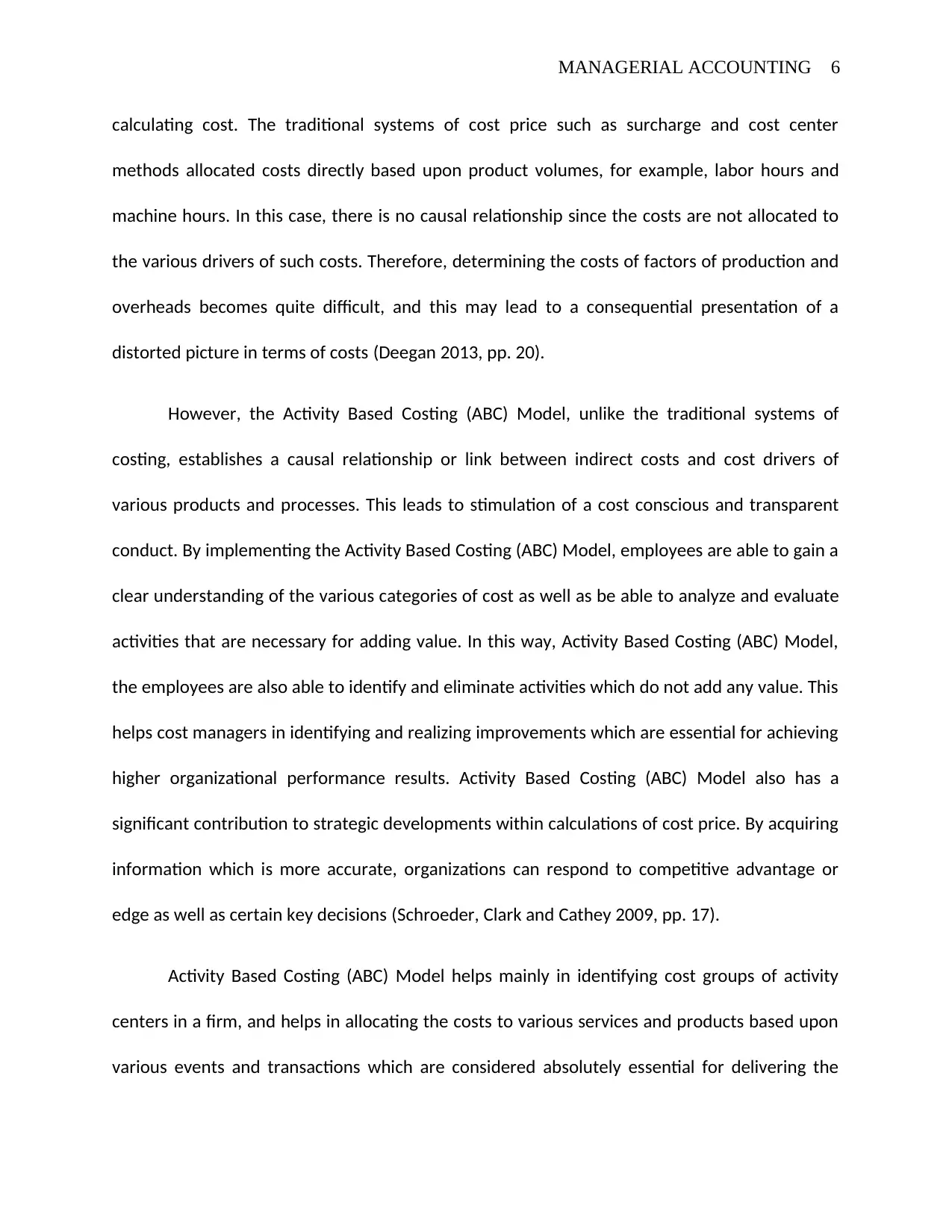
MANAGERIAL ACCOUNTING 6
calculating cost. The traditional systems of cost price such as surcharge and cost center
methods allocated costs directly based upon product volumes, for example, labor hours and
machine hours. In this case, there is no causal relationship since the costs are not allocated to
the various drivers of such costs. Therefore, determining the costs of factors of production and
overheads becomes quite difficult, and this may lead to a consequential presentation of a
distorted picture in terms of costs (Deegan 2013, pp. 20).
However, the Activity Based Costing (ABC) Model, unlike the traditional systems of
costing, establishes a causal relationship or link between indirect costs and cost drivers of
various products and processes. This leads to stimulation of a cost conscious and transparent
conduct. By implementing the Activity Based Costing (ABC) Model, employees are able to gain a
clear understanding of the various categories of cost as well as be able to analyze and evaluate
activities that are necessary for adding value. In this way, Activity Based Costing (ABC) Model,
the employees are also able to identify and eliminate activities which do not add any value. This
helps cost managers in identifying and realizing improvements which are essential for achieving
higher organizational performance results. Activity Based Costing (ABC) Model also has a
significant contribution to strategic developments within calculations of cost price. By acquiring
information which is more accurate, organizations can respond to competitive advantage or
edge as well as certain key decisions (Schroeder, Clark and Cathey 2009, pp. 17).
Activity Based Costing (ABC) Model helps mainly in identifying cost groups of activity
centers in a firm, and helps in allocating the costs to various services and products based upon
various events and transactions which are considered absolutely essential for delivering the
calculating cost. The traditional systems of cost price such as surcharge and cost center
methods allocated costs directly based upon product volumes, for example, labor hours and
machine hours. In this case, there is no causal relationship since the costs are not allocated to
the various drivers of such costs. Therefore, determining the costs of factors of production and
overheads becomes quite difficult, and this may lead to a consequential presentation of a
distorted picture in terms of costs (Deegan 2013, pp. 20).
However, the Activity Based Costing (ABC) Model, unlike the traditional systems of
costing, establishes a causal relationship or link between indirect costs and cost drivers of
various products and processes. This leads to stimulation of a cost conscious and transparent
conduct. By implementing the Activity Based Costing (ABC) Model, employees are able to gain a
clear understanding of the various categories of cost as well as be able to analyze and evaluate
activities that are necessary for adding value. In this way, Activity Based Costing (ABC) Model,
the employees are also able to identify and eliminate activities which do not add any value. This
helps cost managers in identifying and realizing improvements which are essential for achieving
higher organizational performance results. Activity Based Costing (ABC) Model also has a
significant contribution to strategic developments within calculations of cost price. By acquiring
information which is more accurate, organizations can respond to competitive advantage or
edge as well as certain key decisions (Schroeder, Clark and Cathey 2009, pp. 17).
Activity Based Costing (ABC) Model helps mainly in identifying cost groups of activity
centers in a firm, and helps in allocating the costs to various services and products based upon
various events and transactions which are considered absolutely essential for delivering the
⊘ This is a preview!⊘
Do you want full access?
Subscribe today to unlock all pages.

Trusted by 1+ million students worldwide
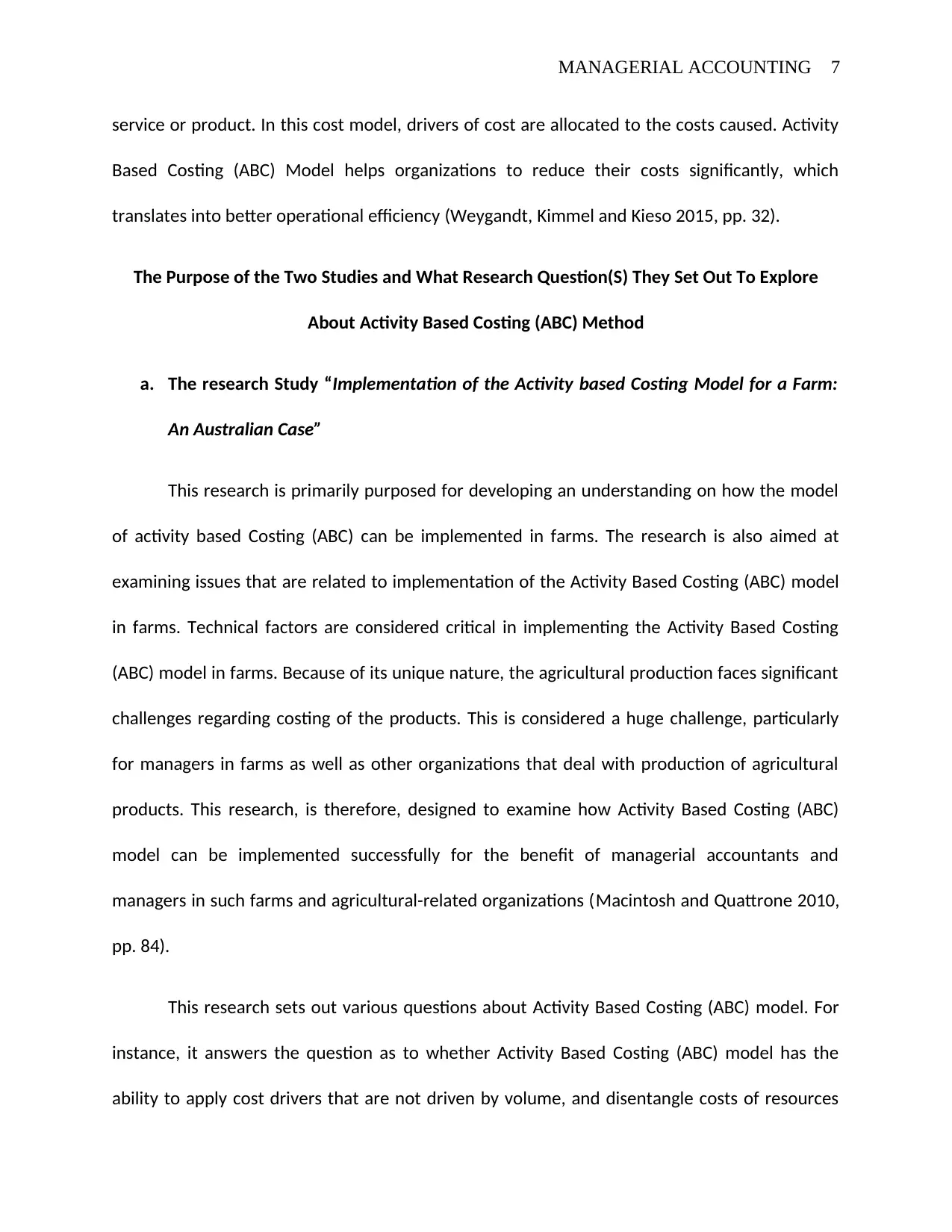
MANAGERIAL ACCOUNTING 7
service or product. In this cost model, drivers of cost are allocated to the costs caused. Activity
Based Costing (ABC) Model helps organizations to reduce their costs significantly, which
translates into better operational efficiency (Weygandt, Kimmel and Kieso 2015, pp. 32).
The Purpose of the Two Studies and What Research Question(S) They Set Out To Explore
About Activity Based Costing (ABC) Method
a. The research Study “Implementation of the Activity based Costing Model for a Farm:
An Australian Case”
This research is primarily purposed for developing an understanding on how the model
of activity based Costing (ABC) can be implemented in farms. The research is also aimed at
examining issues that are related to implementation of the Activity Based Costing (ABC) model
in farms. Technical factors are considered critical in implementing the Activity Based Costing
(ABC) model in farms. Because of its unique nature, the agricultural production faces significant
challenges regarding costing of the products. This is considered a huge challenge, particularly
for managers in farms as well as other organizations that deal with production of agricultural
products. This research, is therefore, designed to examine how Activity Based Costing (ABC)
model can be implemented successfully for the benefit of managerial accountants and
managers in such farms and agricultural-related organizations (Macintosh and Quattrone 2010,
pp. 84).
This research sets out various questions about Activity Based Costing (ABC) model. For
instance, it answers the question as to whether Activity Based Costing (ABC) model has the
ability to apply cost drivers that are not driven by volume, and disentangle costs of resources
service or product. In this cost model, drivers of cost are allocated to the costs caused. Activity
Based Costing (ABC) Model helps organizations to reduce their costs significantly, which
translates into better operational efficiency (Weygandt, Kimmel and Kieso 2015, pp. 32).
The Purpose of the Two Studies and What Research Question(S) They Set Out To Explore
About Activity Based Costing (ABC) Method
a. The research Study “Implementation of the Activity based Costing Model for a Farm:
An Australian Case”
This research is primarily purposed for developing an understanding on how the model
of activity based Costing (ABC) can be implemented in farms. The research is also aimed at
examining issues that are related to implementation of the Activity Based Costing (ABC) model
in farms. Technical factors are considered critical in implementing the Activity Based Costing
(ABC) model in farms. Because of its unique nature, the agricultural production faces significant
challenges regarding costing of the products. This is considered a huge challenge, particularly
for managers in farms as well as other organizations that deal with production of agricultural
products. This research, is therefore, designed to examine how Activity Based Costing (ABC)
model can be implemented successfully for the benefit of managerial accountants and
managers in such farms and agricultural-related organizations (Macintosh and Quattrone 2010,
pp. 84).
This research sets out various questions about Activity Based Costing (ABC) model. For
instance, it answers the question as to whether Activity Based Costing (ABC) model has the
ability to apply cost drivers that are not driven by volume, and disentangle costs of resources
Paraphrase This Document
Need a fresh take? Get an instant paraphrase of this document with our AI Paraphraser
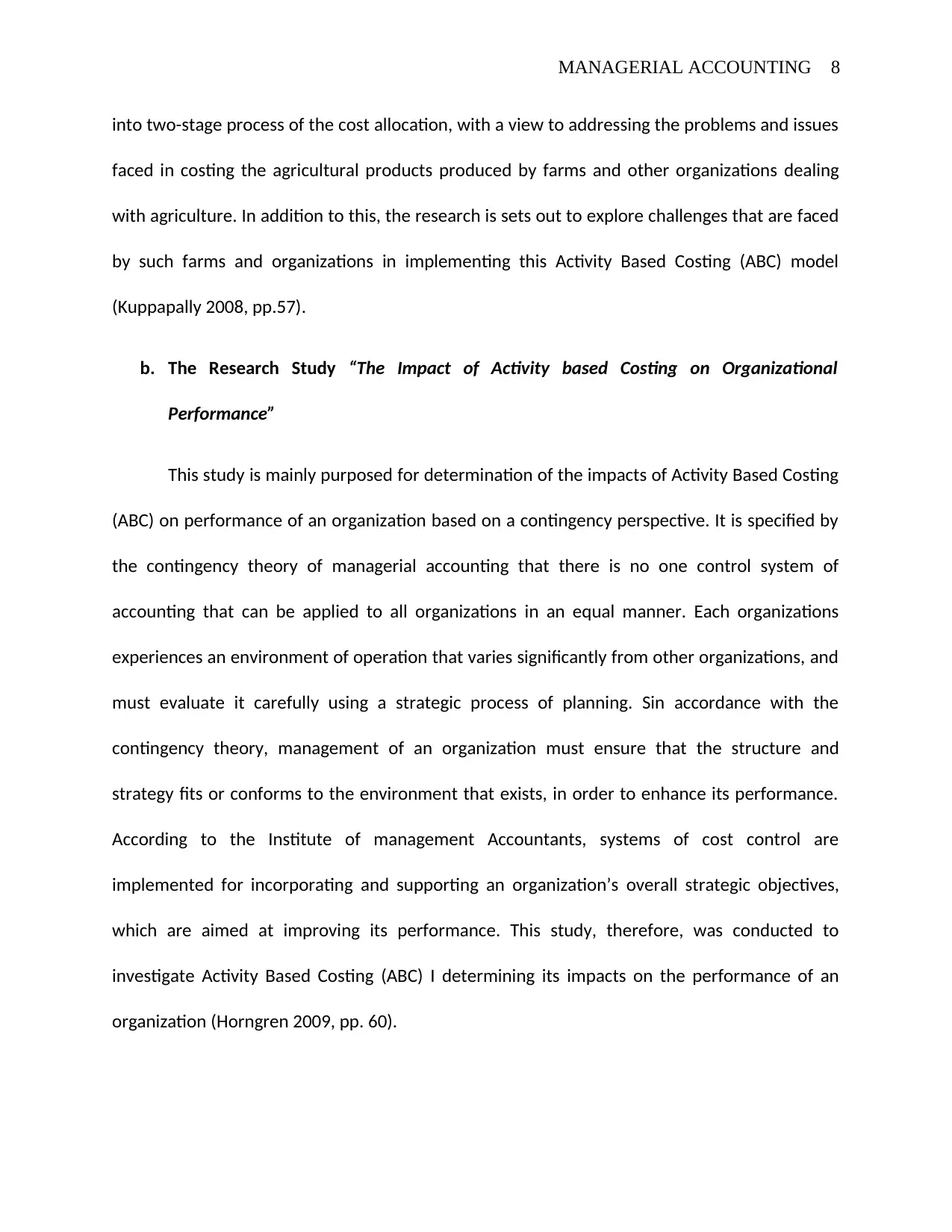
MANAGERIAL ACCOUNTING 8
into two-stage process of the cost allocation, with a view to addressing the problems and issues
faced in costing the agricultural products produced by farms and other organizations dealing
with agriculture. In addition to this, the research is sets out to explore challenges that are faced
by such farms and organizations in implementing this Activity Based Costing (ABC) model
(Kuppapally 2008, pp.57).
b. The Research Study “The Impact of Activity based Costing on Organizational
Performance”
This study is mainly purposed for determination of the impacts of Activity Based Costing
(ABC) on performance of an organization based on a contingency perspective. It is specified by
the contingency theory of managerial accounting that there is no one control system of
accounting that can be applied to all organizations in an equal manner. Each organizations
experiences an environment of operation that varies significantly from other organizations, and
must evaluate it carefully using a strategic process of planning. Sin accordance with the
contingency theory, management of an organization must ensure that the structure and
strategy fits or conforms to the environment that exists, in order to enhance its performance.
According to the Institute of management Accountants, systems of cost control are
implemented for incorporating and supporting an organization’s overall strategic objectives,
which are aimed at improving its performance. This study, therefore, was conducted to
investigate Activity Based Costing (ABC) I determining its impacts on the performance of an
organization (Horngren 2009, pp. 60).
into two-stage process of the cost allocation, with a view to addressing the problems and issues
faced in costing the agricultural products produced by farms and other organizations dealing
with agriculture. In addition to this, the research is sets out to explore challenges that are faced
by such farms and organizations in implementing this Activity Based Costing (ABC) model
(Kuppapally 2008, pp.57).
b. The Research Study “The Impact of Activity based Costing on Organizational
Performance”
This study is mainly purposed for determination of the impacts of Activity Based Costing
(ABC) on performance of an organization based on a contingency perspective. It is specified by
the contingency theory of managerial accounting that there is no one control system of
accounting that can be applied to all organizations in an equal manner. Each organizations
experiences an environment of operation that varies significantly from other organizations, and
must evaluate it carefully using a strategic process of planning. Sin accordance with the
contingency theory, management of an organization must ensure that the structure and
strategy fits or conforms to the environment that exists, in order to enhance its performance.
According to the Institute of management Accountants, systems of cost control are
implemented for incorporating and supporting an organization’s overall strategic objectives,
which are aimed at improving its performance. This study, therefore, was conducted to
investigate Activity Based Costing (ABC) I determining its impacts on the performance of an
organization (Horngren 2009, pp. 60).
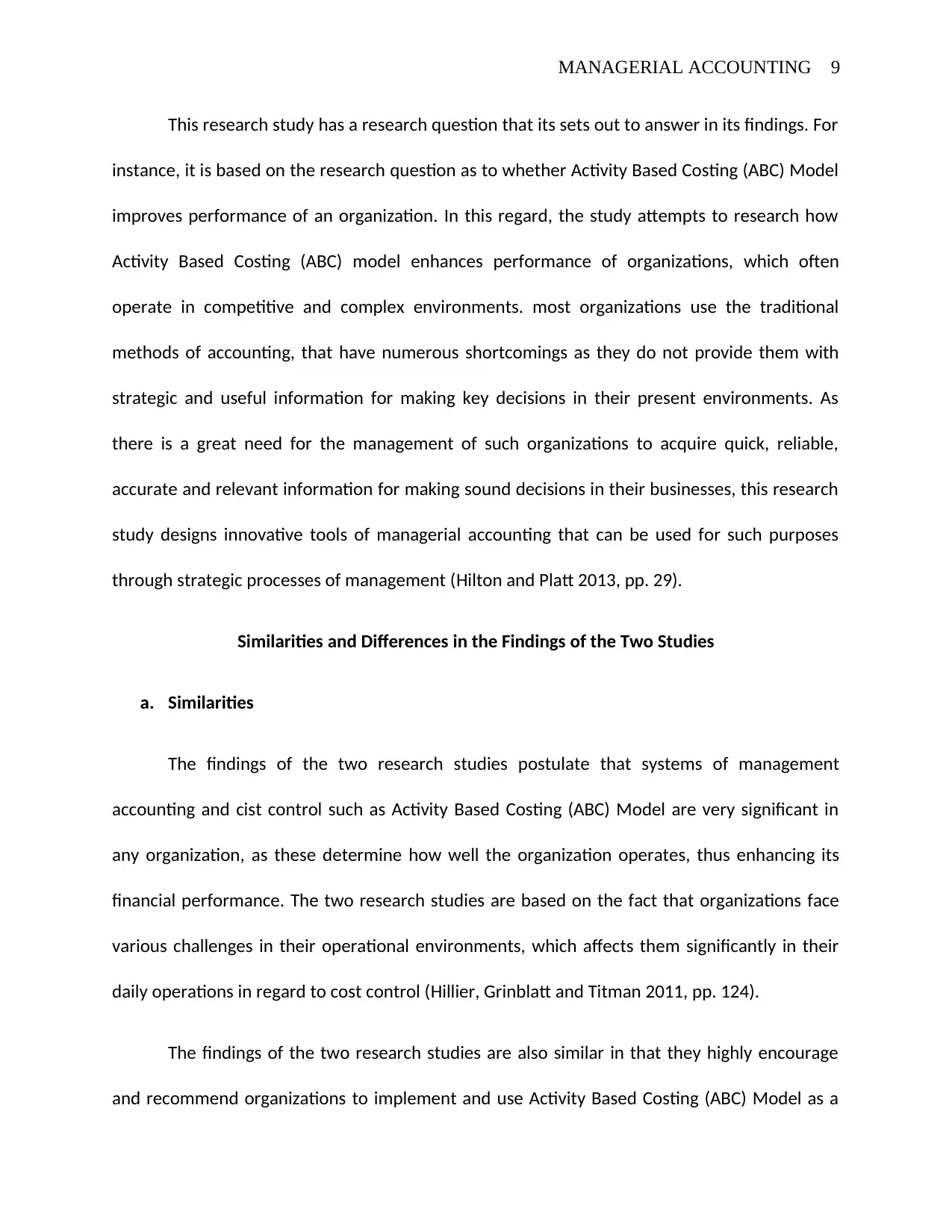
MANAGERIAL ACCOUNTING 9
This research study has a research question that its sets out to answer in its findings. For
instance, it is based on the research question as to whether Activity Based Costing (ABC) Model
improves performance of an organization. In this regard, the study attempts to research how
Activity Based Costing (ABC) model enhances performance of organizations, which often
operate in competitive and complex environments. most organizations use the traditional
methods of accounting, that have numerous shortcomings as they do not provide them with
strategic and useful information for making key decisions in their present environments. As
there is a great need for the management of such organizations to acquire quick, reliable,
accurate and relevant information for making sound decisions in their businesses, this research
study designs innovative tools of managerial accounting that can be used for such purposes
through strategic processes of management (Hilton and Platt 2013, pp. 29).
Similarities and Differences in the Findings of the Two Studies
a. Similarities
The findings of the two research studies postulate that systems of management
accounting and cist control such as Activity Based Costing (ABC) Model are very significant in
any organization, as these determine how well the organization operates, thus enhancing its
financial performance. The two research studies are based on the fact that organizations face
various challenges in their operational environments, which affects them significantly in their
daily operations in regard to cost control (Hillier, Grinblatt and Titman 2011, pp. 124).
The findings of the two research studies are also similar in that they highly encourage
and recommend organizations to implement and use Activity Based Costing (ABC) Model as a
This research study has a research question that its sets out to answer in its findings. For
instance, it is based on the research question as to whether Activity Based Costing (ABC) Model
improves performance of an organization. In this regard, the study attempts to research how
Activity Based Costing (ABC) model enhances performance of organizations, which often
operate in competitive and complex environments. most organizations use the traditional
methods of accounting, that have numerous shortcomings as they do not provide them with
strategic and useful information for making key decisions in their present environments. As
there is a great need for the management of such organizations to acquire quick, reliable,
accurate and relevant information for making sound decisions in their businesses, this research
study designs innovative tools of managerial accounting that can be used for such purposes
through strategic processes of management (Hilton and Platt 2013, pp. 29).
Similarities and Differences in the Findings of the Two Studies
a. Similarities
The findings of the two research studies postulate that systems of management
accounting and cist control such as Activity Based Costing (ABC) Model are very significant in
any organization, as these determine how well the organization operates, thus enhancing its
financial performance. The two research studies are based on the fact that organizations face
various challenges in their operational environments, which affects them significantly in their
daily operations in regard to cost control (Hillier, Grinblatt and Titman 2011, pp. 124).
The findings of the two research studies are also similar in that they highly encourage
and recommend organizations to implement and use Activity Based Costing (ABC) Model as a
⊘ This is a preview!⊘
Do you want full access?
Subscribe today to unlock all pages.

Trusted by 1+ million students worldwide
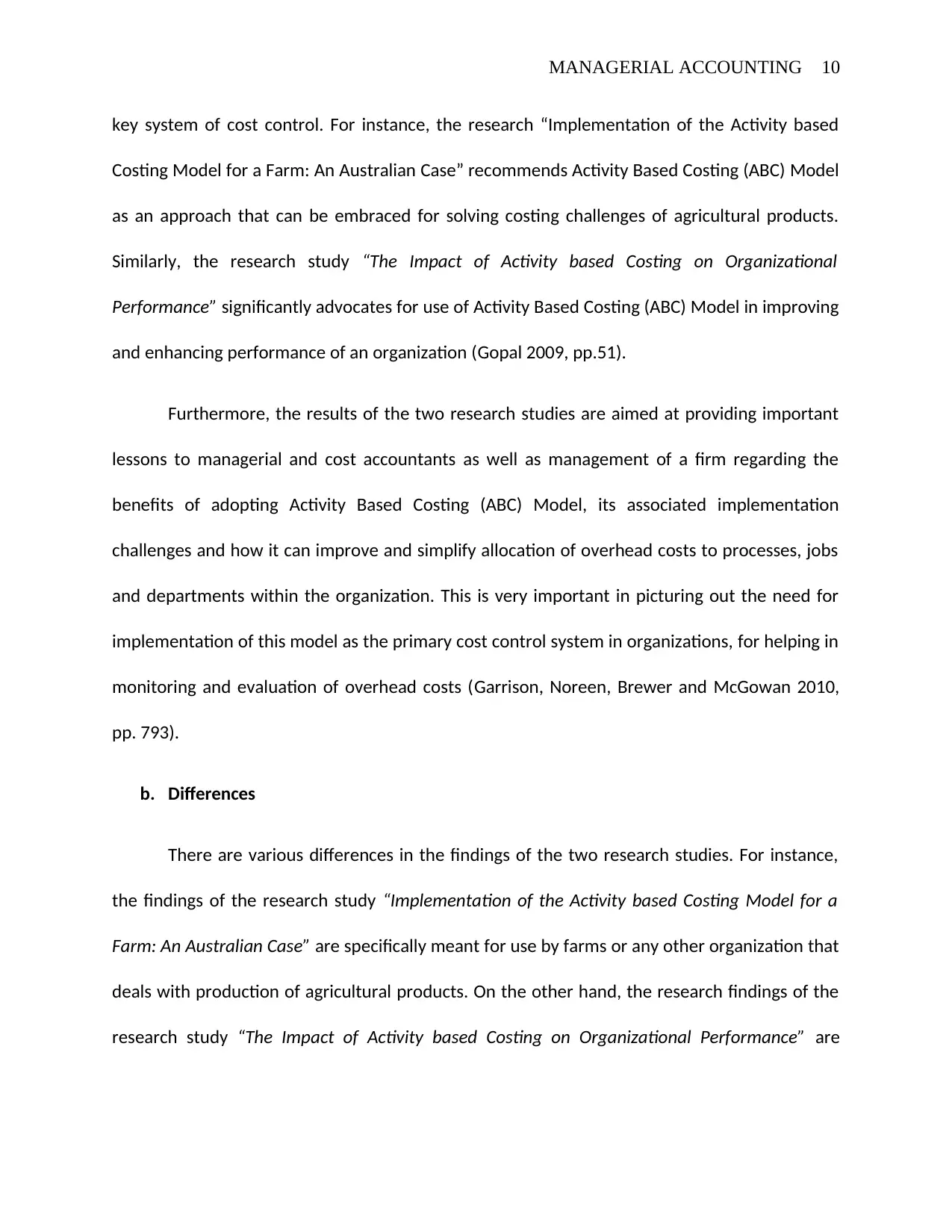
MANAGERIAL ACCOUNTING 10
key system of cost control. For instance, the research “Implementation of the Activity based
Costing Model for a Farm: An Australian Case” recommends Activity Based Costing (ABC) Model
as an approach that can be embraced for solving costing challenges of agricultural products.
Similarly, the research study “The Impact of Activity based Costing on Organizational
Performance” significantly advocates for use of Activity Based Costing (ABC) Model in improving
and enhancing performance of an organization (Gopal 2009, pp.51).
Furthermore, the results of the two research studies are aimed at providing important
lessons to managerial and cost accountants as well as management of a firm regarding the
benefits of adopting Activity Based Costing (ABC) Model, its associated implementation
challenges and how it can improve and simplify allocation of overhead costs to processes, jobs
and departments within the organization. This is very important in picturing out the need for
implementation of this model as the primary cost control system in organizations, for helping in
monitoring and evaluation of overhead costs (Garrison, Noreen, Brewer and McGowan 2010,
pp. 793).
b. Differences
There are various differences in the findings of the two research studies. For instance,
the findings of the research study “Implementation of the Activity based Costing Model for a
Farm: An Australian Case” are specifically meant for use by farms or any other organization that
deals with production of agricultural products. On the other hand, the research findings of the
research study “The Impact of Activity based Costing on Organizational Performance” are
key system of cost control. For instance, the research “Implementation of the Activity based
Costing Model for a Farm: An Australian Case” recommends Activity Based Costing (ABC) Model
as an approach that can be embraced for solving costing challenges of agricultural products.
Similarly, the research study “The Impact of Activity based Costing on Organizational
Performance” significantly advocates for use of Activity Based Costing (ABC) Model in improving
and enhancing performance of an organization (Gopal 2009, pp.51).
Furthermore, the results of the two research studies are aimed at providing important
lessons to managerial and cost accountants as well as management of a firm regarding the
benefits of adopting Activity Based Costing (ABC) Model, its associated implementation
challenges and how it can improve and simplify allocation of overhead costs to processes, jobs
and departments within the organization. This is very important in picturing out the need for
implementation of this model as the primary cost control system in organizations, for helping in
monitoring and evaluation of overhead costs (Garrison, Noreen, Brewer and McGowan 2010,
pp. 793).
b. Differences
There are various differences in the findings of the two research studies. For instance,
the findings of the research study “Implementation of the Activity based Costing Model for a
Farm: An Australian Case” are specifically meant for use by farms or any other organization that
deals with production of agricultural products. On the other hand, the research findings of the
research study “The Impact of Activity based Costing on Organizational Performance” are
Paraphrase This Document
Need a fresh take? Get an instant paraphrase of this document with our AI Paraphraser
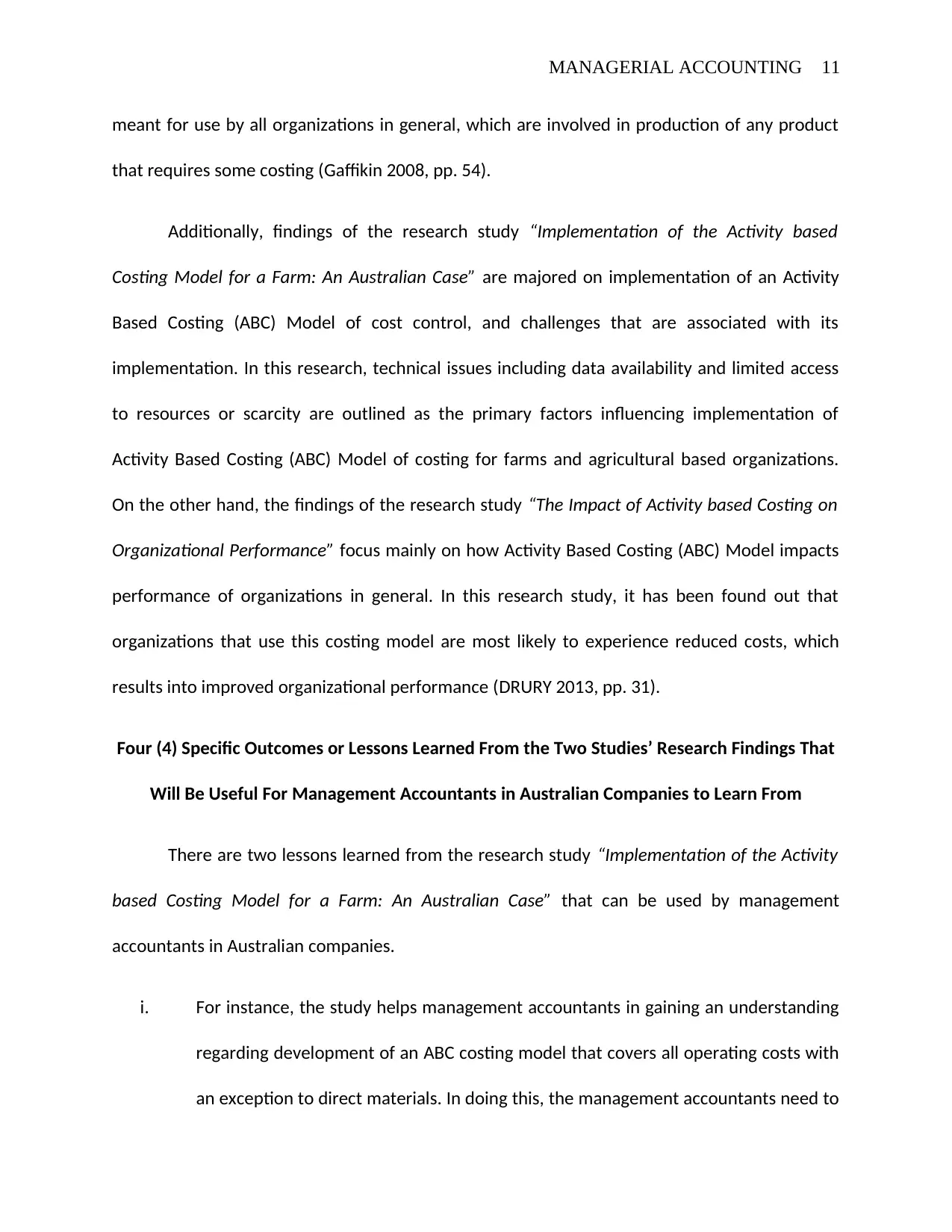
MANAGERIAL ACCOUNTING 11
meant for use by all organizations in general, which are involved in production of any product
that requires some costing (Gaffikin 2008, pp. 54).
Additionally, findings of the research study “Implementation of the Activity based
Costing Model for a Farm: An Australian Case” are majored on implementation of an Activity
Based Costing (ABC) Model of cost control, and challenges that are associated with its
implementation. In this research, technical issues including data availability and limited access
to resources or scarcity are outlined as the primary factors influencing implementation of
Activity Based Costing (ABC) Model of costing for farms and agricultural based organizations.
On the other hand, the findings of the research study “The Impact of Activity based Costing on
Organizational Performance” focus mainly on how Activity Based Costing (ABC) Model impacts
performance of organizations in general. In this research study, it has been found out that
organizations that use this costing model are most likely to experience reduced costs, which
results into improved organizational performance (DRURY 2013, pp. 31).
Four (4) Specific Outcomes or Lessons Learned From the Two Studies’ Research Findings That
Will Be Useful For Management Accountants in Australian Companies to Learn From
There are two lessons learned from the research study “Implementation of the Activity
based Costing Model for a Farm: An Australian Case” that can be used by management
accountants in Australian companies.
i. For instance, the study helps management accountants in gaining an understanding
regarding development of an ABC costing model that covers all operating costs with
an exception to direct materials. In doing this, the management accountants need to
meant for use by all organizations in general, which are involved in production of any product
that requires some costing (Gaffikin 2008, pp. 54).
Additionally, findings of the research study “Implementation of the Activity based
Costing Model for a Farm: An Australian Case” are majored on implementation of an Activity
Based Costing (ABC) Model of cost control, and challenges that are associated with its
implementation. In this research, technical issues including data availability and limited access
to resources or scarcity are outlined as the primary factors influencing implementation of
Activity Based Costing (ABC) Model of costing for farms and agricultural based organizations.
On the other hand, the findings of the research study “The Impact of Activity based Costing on
Organizational Performance” focus mainly on how Activity Based Costing (ABC) Model impacts
performance of organizations in general. In this research study, it has been found out that
organizations that use this costing model are most likely to experience reduced costs, which
results into improved organizational performance (DRURY 2013, pp. 31).
Four (4) Specific Outcomes or Lessons Learned From the Two Studies’ Research Findings That
Will Be Useful For Management Accountants in Australian Companies to Learn From
There are two lessons learned from the research study “Implementation of the Activity
based Costing Model for a Farm: An Australian Case” that can be used by management
accountants in Australian companies.
i. For instance, the study helps management accountants in gaining an understanding
regarding development of an ABC costing model that covers all operating costs with
an exception to direct materials. In doing this, the management accountants need to
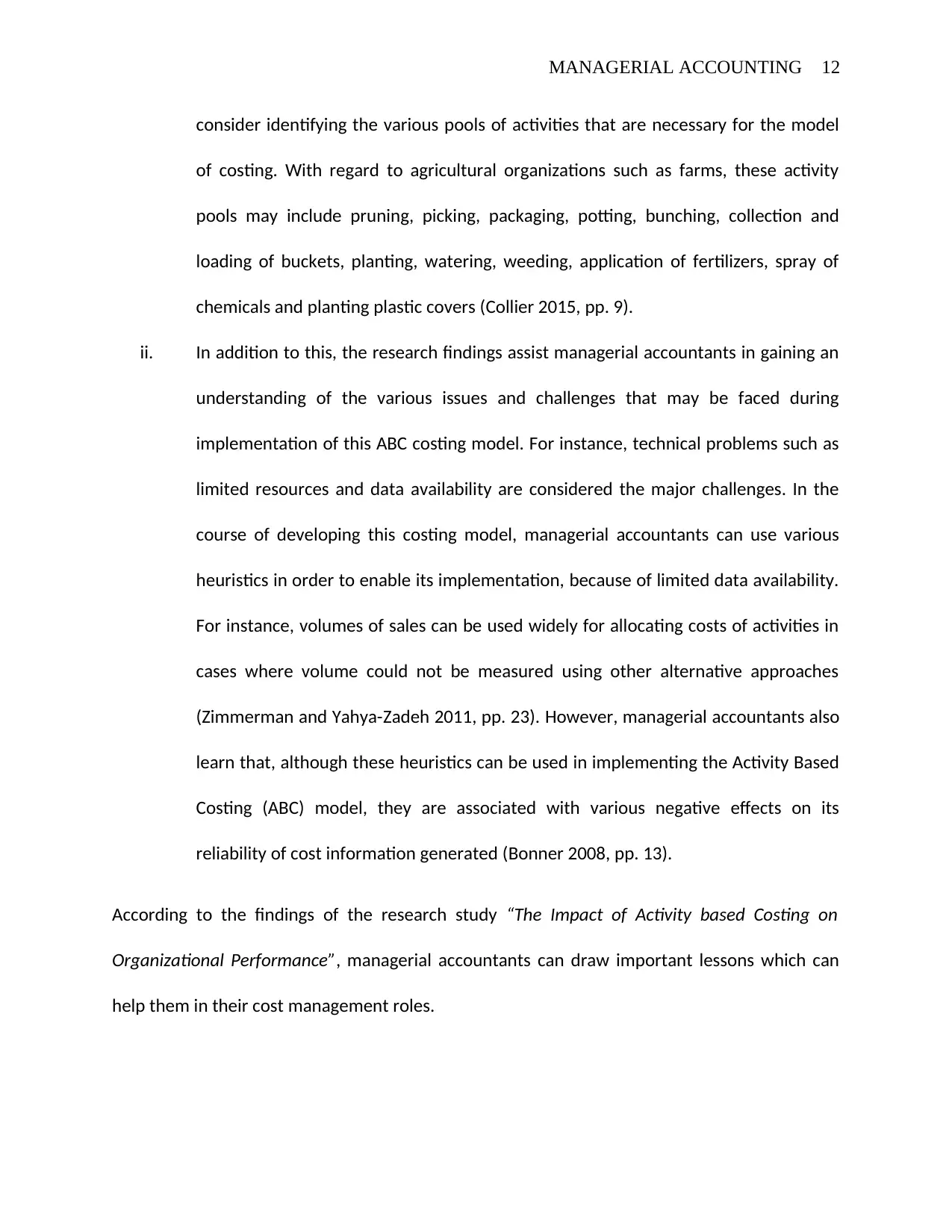
MANAGERIAL ACCOUNTING 12
consider identifying the various pools of activities that are necessary for the model
of costing. With regard to agricultural organizations such as farms, these activity
pools may include pruning, picking, packaging, potting, bunching, collection and
loading of buckets, planting, watering, weeding, application of fertilizers, spray of
chemicals and planting plastic covers (Collier 2015, pp. 9).
ii. In addition to this, the research findings assist managerial accountants in gaining an
understanding of the various issues and challenges that may be faced during
implementation of this ABC costing model. For instance, technical problems such as
limited resources and data availability are considered the major challenges. In the
course of developing this costing model, managerial accountants can use various
heuristics in order to enable its implementation, because of limited data availability.
For instance, volumes of sales can be used widely for allocating costs of activities in
cases where volume could not be measured using other alternative approaches
(Zimmerman and Yahya-Zadeh 2011, pp. 23). However, managerial accountants also
learn that, although these heuristics can be used in implementing the Activity Based
Costing (ABC) model, they are associated with various negative effects on its
reliability of cost information generated (Bonner 2008, pp. 13).
According to the findings of the research study “The Impact of Activity based Costing on
Organizational Performance”, managerial accountants can draw important lessons which can
help them in their cost management roles.
consider identifying the various pools of activities that are necessary for the model
of costing. With regard to agricultural organizations such as farms, these activity
pools may include pruning, picking, packaging, potting, bunching, collection and
loading of buckets, planting, watering, weeding, application of fertilizers, spray of
chemicals and planting plastic covers (Collier 2015, pp. 9).
ii. In addition to this, the research findings assist managerial accountants in gaining an
understanding of the various issues and challenges that may be faced during
implementation of this ABC costing model. For instance, technical problems such as
limited resources and data availability are considered the major challenges. In the
course of developing this costing model, managerial accountants can use various
heuristics in order to enable its implementation, because of limited data availability.
For instance, volumes of sales can be used widely for allocating costs of activities in
cases where volume could not be measured using other alternative approaches
(Zimmerman and Yahya-Zadeh 2011, pp. 23). However, managerial accountants also
learn that, although these heuristics can be used in implementing the Activity Based
Costing (ABC) model, they are associated with various negative effects on its
reliability of cost information generated (Bonner 2008, pp. 13).
According to the findings of the research study “The Impact of Activity based Costing on
Organizational Performance”, managerial accountants can draw important lessons which can
help them in their cost management roles.
⊘ This is a preview!⊘
Do you want full access?
Subscribe today to unlock all pages.

Trusted by 1+ million students worldwide
1 out of 16
Related Documents
Your All-in-One AI-Powered Toolkit for Academic Success.
+13062052269
info@desklib.com
Available 24*7 on WhatsApp / Email
![[object Object]](/_next/static/media/star-bottom.7253800d.svg)
Unlock your academic potential
Copyright © 2020–2025 A2Z Services. All Rights Reserved. Developed and managed by ZUCOL.



